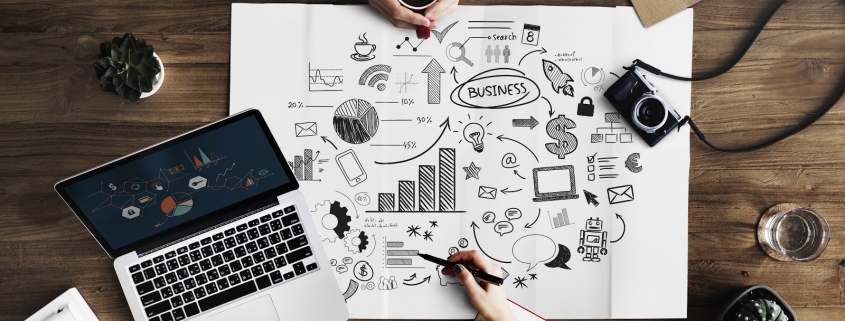Incorporating the Flywheel into the Buyer’s Journey
Today’s buyers are in control and are more empowered than ever before. Traditional purchasing and customer loyalty have changed dramatically and it is up to you to evolve your marketing, sales and customer service around this new way of buying.
Inbound is a business philosophy that is centered around helping people, sharing your knowledge, and aligning your company’s purpose with the way your buyers think, research and purchase. It’s about meeting your customers where THEY are in their journey and placing them at the center of your processes. Easy to say, but how exactly is this done?
The answer… incorporate the inbound flywheel into your buyer’s journey and keep customers at the center of your business.
Buyer’s Journey to Flywheel
Traditionally, the Buyer’s Journey consists of three to five steps that basically boil down to awareness, consideration, and decision. However, this concept of moving prospects through a sales funnel, has the consumer dropping off once the journey is complete; redirecting all efforts to the new prospects at the top of the funnel.
With a goal to eliminate customer drop off, HubSpot’s CEO, Brian Halligan introduced the Flywheel Model as a solution to this flawed concept. By integrating the Flywheel into your inbound processes, you’re putting the customer at the center of your company and processes. This methodology reduces friction, increases word of mouth leads, and generates more repeat business. By attracting, engaging and delighting your customers with amazing experiences throughout their lifecycle they become promoters of your business.
Use the Flywheel to understand where your buyers are in their journey so you can provide relevant and useful information that will move them towards your product or services and keep them engaged and delighted to continue to fuel your pipeline.
Attract – Provide Your Prospects Value
During this stage, your prospect is experiencing a problem, but they may not even know you exist yet. They are researching to be educated. They are looking for educational content, opinions, and insight (often called top of the funnel or TOF content). To attract prospects in this stage, try using helpful and contextual content to speak to them while providing free, relevant information.
Take this a step further and start spinning the wheel. Demonstrate your knowledge as a thought leader in your field and use simple, smart content to capture an email and company name. Use this information to nurture the lead with helpful and useful information. Delight them from the start.
Awareness stage content examples:
- Blog Posts
- Educational Content
- Social Media Posts
- Expert Content
Engage – Offer a Personalized and Effortless Experience
This is a crucial point in the lifecycle of your prospect, encompassing both the consideration and decision stage. By incorporating the flywheel methodology, you can provide a personalized and tailored experience throughout the engagement to increase opportunities to close as well as opportunities to delight.
During the consideration stage, your prospect has clearly defined their problem and are researching different solutions to meet their business’ needs and goals.
Consideration stage content examples include:
- Checklists
- Templates
- Ebooks
- Live Interactions
Unfortunately, offering this alone will not be enough. In addition to providing solution-based content that proves yours is the best option, engaging with prospects is a must.
Keep in mind… a prospect may want to engage at any level of their journey and through different channels. You must be prepared; aligning all levels of service around the same goal.
Now that your prospect is fully educated and has had a seamless interaction with your brand, they’re ready to make a decision. Prospects now want to know how you’ve helped others in the past and what tools best fit their needs. Take this opportunity to increase engagement with personalization through smart content, and provide “bottom of the funnel” content to push them to their final decision.
Decision stage content examples:
- Case Studies
- Live Demo
- Webinars
- Trial Download
Once the prospect is ready to purchase, addressing mutual fit is critical. Ensure that you are targeting the right audience for your market from the start. You’ll not only increase customer retention but you’ll also find more opportunities for repeat business. The more qualified leads you are able to identify, the more potential business your company can win.
Delight – Customer Success is Your Success
In the final stage of the Buyer’s Journey, your prospect has made their purchase and you move on to the next deal. But, the Flywheel keeps spinning, so you are not done. Delight your customers into promoters and you can become your very own, best case study.
Content here should be relationship-centric. Check-in with your new customers and offer any relevant solutions or new information. Continue to offer highly targeted, shareable content so that the prospect feels engaged and appreciated, becoming an advocate for your product or service.
Opportunities to delight:
- Provide surveys to ensure satisfaction
- Seek to solve your customers’ problems
- Be accessible and authentic
- Help customers succeed.
At every stage of the Buyer’s Journey, you have an opportunity to educate, provide assistance, and excite your prospects and customers. Find out what that journey looks like for your prospects and use these tools to attract, engage and delight your current and future customers and prospects.
If you’d like to learn more about generating leads with inbound or need help in developing a strategy around your buyer’s journey, let us know!
Wait… When was the last time you updated your buyer personas?
Download our Free, Customizable eBook to Create Personalized Buyer Personas for Your Business!



